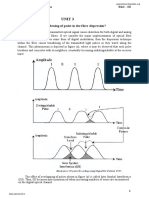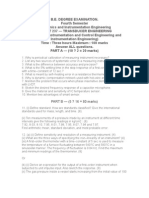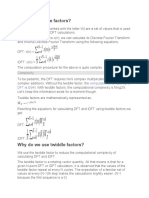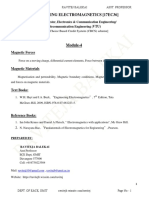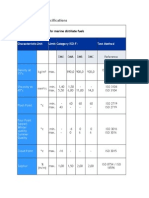Digital Electronics and Microprocessor Lecture Notes
Uploaded by
514 Vaibhavi PawarDigital Electronics and Microprocessor Lecture Notes
Uploaded by
514 Vaibhavi PawarDIGITAL ELECTRONICS AND MICROPROCES S OR
DIGITAL ELECTRONICS AND MICROPROCESSOR
LECTURE NOTES (Semester – III)
for
Bachelor of Science in Computer Science
Department of Computer Science
School of Arts & Science
Vinayaka Mission’s Research Foundation
A V Campus, Chennai – 603104.
Lecture Notes Prepared by:
A. VIJAYA KUMAR, Asst. Professor Grade-II
VIJAYA KUMAR. A, AP-G II, DEPT OF CSA, SAS, VMRF
DIGITAL ELECTRONICS AND MICROPROCES S OR
Outcomes : After the completion of this course, a successful student will be able to do
the following:
1. Design and implement Combinational circuits.
2. Design and implement synchronous and asynchronous sequential
circuits
3. perform experiments on assembly language programming
4. analyze the data transfer information through serial & parallel
ports.
L T P C
4 0 0 4
UNIT I 12 Hours
Binary Systems & Code conversion, Boolean Algebra & Logic Gates –Truth Tables –Universal
Gates –Simplification of Boolean functions: SOP, POS methods –K-map, –Combinational
Logic: Adders & Subtractors –Multiplexer –Demultiplexer -Encoder –Decoder.
UNIT II 12 Hours
Sequential Logic: RS, Clocked RS, D, JK, Master Slave JK, T Flip-Flops –Shift Registers –
Types of Shift Registers –Counters: Ripple Counter –Synchronous Counters –Up-Down
Counter.
UNIT III 12 Hours
Introduction to Microprocessor – Evolution of microprocessor – general architecture of
microprocessor system – architecture of 8085 A – pin configuration– machine language and
assembly language. The 8085 instruction set - Instruction classification – instruction and data
format – addressing modes – instruction set of 8085 – data transfer operations, arithmetic
operations, logic operations, Stack operations, I/O operations and machine control operations
– programming techniques such as looping counting and indexing.
UNIT IV 12 Hours
Programming a Microprocessor – Program writing for 8-bit addition, subtraction,
multiplication and division – 16 bit addition, subtraction, multiplication – BCD addition and
subtraction – BCD to binary and binary to BCD conversion – octal to binary conversion –
ASCII to BCD and BCD to ASCII conversions – ASCII to binary and binary to ASCII
conversions – biggest and smallest – sorting and searching – block data transfer.
UNIT V 12 Hours
Counters and time delays – Time delay using single register and register pair hexadecimal
counter. Timing sequences – opcode fetch cycle – memory read cycle – memory write cycle –
I/O read cycle – I/O write cycle. Data transfer methods - Memory organization – memory
mapping – I/O mapping
TEXT BOOKS:
1. M. Morris Mano, 2005, Digital Logic and Computer Design, Prentice-Hall of India
Pvt. Ltd.
2. Introduction to Microprocessor – A.P. Mathur, TMH-2007
VIJAYA KUMAR. A, AP-G II, DEPT OF CSA, SAS, VMRF
DIGITAL ELECTRONICS AND MICROPROCES S OR UNIT I
UNIT I
VIJAYA KUMAR. A, AP-G II, DEPT OF CSA, SAS, VMRF
DIGITAL ELECTRONICS AND MICROPROCES S OR UNIT II
UNIT II
VIJAYA KUMAR. A, AP-G II, DEPT OF CSA, SAS, VMRF
DIGITAL ELECTRONICS AND MICROPROCES S OR UNIT III
UNIT III
VIJAYA KUMAR. A, AP-G II, DEPT OF CSA, SAS, VMRF
DIGITAL ELECTRONICS AND MICROPROCES S OR UNIT IV
UNIT IV
VIJAYA KUMAR. A, AP-G II, DEPT OF CSA, SAS, VMRF
DIGITAL ELECTRONICS AND MICROPROCES S OR UNIT V
UNIT V
VIJAYA KUMAR. A, AP-G II, DEPT OF CSA, SAS, VMRF
You might also like
- Component Diagnostics: E1 - Engine Control Unit: ECU Pin and PlugNo ratings yetComponent Diagnostics: E1 - Engine Control Unit: ECU Pin and Plug9 pages
- Wireless Communication Handwritten Notes PDF100% (1)Wireless Communication Handwritten Notes PDF97 pages
- Komatsu Truck 930-4 Shop Manual CEBM01790486% (7)Komatsu Truck 930-4 Shop Manual CEBM0179041,027 pages
- Basic Electronics (BBEE103/BBEE203) - Field Effect Transistors (Module 2)No ratings yetBasic Electronics (BBEE103/BBEE203) - Field Effect Transistors (Module 2)74 pages
- Engineering Mathematics I Question Bank With Answer KeyNo ratings yetEngineering Mathematics I Question Bank With Answer Key10 pages
- Unit 3: Write Notes On Broadening of Pulse in The Fiber Dispersion?No ratings yetUnit 3: Write Notes On Broadening of Pulse in The Fiber Dispersion?13 pages
- Eee-III-Analog Electronic Circuits (15ee34) - SolutionNo ratings yetEee-III-Analog Electronic Circuits (15ee34) - Solution48 pages
- Clipping at Two Independent Levels: Department of Electronicsand Communication EngineeringNo ratings yetClipping at Two Independent Levels: Department of Electronicsand Communication Engineering13 pages
- Parallel Bus Device Protocols: Parallel Communication Network Using ISA/EISA PCI/PCI-X Advanced Buses100% (1)Parallel Bus Device Protocols: Parallel Communication Network Using ISA/EISA PCI/PCI-X Advanced Buses14 pages
- Computer System Security (CSS) KNC - 301No ratings yetComputer System Security (CSS) KNC - 30145 pages
- 1.7 Circuit Switching - 1.8 Packet Switching NotesNo ratings yet1.7 Circuit Switching - 1.8 Packet Switching Notes11 pages
- Examples On Radix-2 DIT-FFT Algorithm 1) Use The 8-Point Radix-2 DIT-FFT Algorithm To Find The DFT of The Sequence X (N) (0.707,1,0.707,0, - 0.707,-1,-0.707,-0)No ratings yetExamples On Radix-2 DIT-FFT Algorithm 1) Use The 8-Point Radix-2 DIT-FFT Algorithm To Find The DFT of The Sequence X (N) (0.707,1,0.707,0, - 0.707,-1,-0.707,-0)2 pages
- Electronic Circuits (Unit 3) - Feedback Amplifiers Handwritten Notes Material Uploaded byNo ratings yetElectronic Circuits (Unit 3) - Feedback Amplifiers Handwritten Notes Material Uploaded by45 pages
- Viva Voce Questions On Communication Systems100% (3)Viva Voce Questions On Communication Systems3 pages
- What Is GTO - Types, Construction, Working and ApplicationsNo ratings yetWhat Is GTO - Types, Construction, Working and Applications22 pages
- Computer Organization and Architecture (18EC35) - Input/Output Organization (Module 3)50% (2)Computer Organization and Architecture (18EC35) - Input/Output Organization (Module 3)82 pages
- 2.a What Is A Digital System? Why Are Digital Systems So Pervasive? AnswerNo ratings yet2.a What Is A Digital System? Why Are Digital Systems So Pervasive? Answer23 pages
- Lecture-20 Polar and Inverse Polar PlotNo ratings yetLecture-20 Polar and Inverse Polar Plot20 pages
- Medha Servo Drives Written Exam Pattern Given by KV Sai KIshore (BVRIT-2005-09-ECE)67% (3)Medha Servo Drives Written Exam Pattern Given by KV Sai KIshore (BVRIT-2005-09-ECE)2 pages
- Experiment: 5 (A) : A) Write A Program For The 8051 To Transfer Letter "A" Serially, ContinuouslyNo ratings yetExperiment: 5 (A) : A) Write A Program For The 8051 To Transfer Letter "A" Serially, Continuously2 pages
- Ec3492-Digital Signal Processing LaboratoryNo ratings yetEc3492-Digital Signal Processing Laboratory80 pages
- Cleaning Public Areas: by Mumtazul IlyaniNo ratings yetCleaning Public Areas: by Mumtazul Ilyani27 pages
- Electrical Vendor Directory Jan 2020 To Jun 20200% (1)Electrical Vendor Directory Jan 2020 To Jun 2020231 pages
- Philosophy and Objectives of Edukasyon Sa PagpapakataoNo ratings yetPhilosophy and Objectives of Edukasyon Sa Pagpapakatao5 pages
- Impact of Social Media in The Growth of Business: A Case Study On Women EntrepreneursNo ratings yetImpact of Social Media in The Growth of Business: A Case Study On Women Entrepreneurs6 pages
- Metal Forming Lecture 3 Stress Strain AnalysesNo ratings yetMetal Forming Lecture 3 Stress Strain Analyses30 pages
- Eagle Quantum Premier 8 Channel Relay Module Model EQ3720RM: Specification DataNo ratings yetEagle Quantum Premier 8 Channel Relay Module Model EQ3720RM: Specification Data4 pages
- Unit 3: Capacity Requirement Planning (CRP)No ratings yetUnit 3: Capacity Requirement Planning (CRP)25 pages
- 119.) 149.product Bulletin Fisher Fieldvue Digital Valve Controller Product Selection en 6112860No ratings yet119.) 149.product Bulletin Fisher Fieldvue Digital Valve Controller Product Selection en 611286010 pages
- Instant download The Mind As a Scientific Object Between Brain and Culture 1st Edition Christina E. Erneling pdf all chapterNo ratings yetInstant download The Mind As a Scientific Object Between Brain and Culture 1st Edition Christina E. Erneling pdf all chapter55 pages
- Hdpe Boru Fiyat Listesi Hdpe Pipe Price ListNo ratings yetHdpe Boru Fiyat Listesi Hdpe Pipe Price List2 pages
- Calculation of Forces On POT / PTFE Bearings-24.60M SPAN & 10.50M DECKNo ratings yetCalculation of Forces On POT / PTFE Bearings-24.60M SPAN & 10.50M DECK6 pages
- Motor Feeder Cable & Cable Tray Sizing and DataNo ratings yetMotor Feeder Cable & Cable Tray Sizing and Data5 pages
- Component Diagnostics: E1 - Engine Control Unit: ECU Pin and PlugComponent Diagnostics: E1 - Engine Control Unit: ECU Pin and Plug
- Basic Electronics (BBEE103/BBEE203) - Field Effect Transistors (Module 2)Basic Electronics (BBEE103/BBEE203) - Field Effect Transistors (Module 2)
- Engineering Mathematics I Question Bank With Answer KeyEngineering Mathematics I Question Bank With Answer Key
- Unit 3: Write Notes On Broadening of Pulse in The Fiber Dispersion?Unit 3: Write Notes On Broadening of Pulse in The Fiber Dispersion?
- Eee-III-Analog Electronic Circuits (15ee34) - SolutionEee-III-Analog Electronic Circuits (15ee34) - Solution
- Clipping at Two Independent Levels: Department of Electronicsand Communication EngineeringClipping at Two Independent Levels: Department of Electronicsand Communication Engineering
- Parallel Bus Device Protocols: Parallel Communication Network Using ISA/EISA PCI/PCI-X Advanced BusesParallel Bus Device Protocols: Parallel Communication Network Using ISA/EISA PCI/PCI-X Advanced Buses
- 1.7 Circuit Switching - 1.8 Packet Switching Notes1.7 Circuit Switching - 1.8 Packet Switching Notes
- Examples On Radix-2 DIT-FFT Algorithm 1) Use The 8-Point Radix-2 DIT-FFT Algorithm To Find The DFT of The Sequence X (N) (0.707,1,0.707,0, - 0.707,-1,-0.707,-0)Examples On Radix-2 DIT-FFT Algorithm 1) Use The 8-Point Radix-2 DIT-FFT Algorithm To Find The DFT of The Sequence X (N) (0.707,1,0.707,0, - 0.707,-1,-0.707,-0)
- Electronic Circuits (Unit 3) - Feedback Amplifiers Handwritten Notes Material Uploaded byElectronic Circuits (Unit 3) - Feedback Amplifiers Handwritten Notes Material Uploaded by
- What Is GTO - Types, Construction, Working and ApplicationsWhat Is GTO - Types, Construction, Working and Applications
- Computer Organization and Architecture (18EC35) - Input/Output Organization (Module 3)Computer Organization and Architecture (18EC35) - Input/Output Organization (Module 3)
- 2.a What Is A Digital System? Why Are Digital Systems So Pervasive? Answer2.a What Is A Digital System? Why Are Digital Systems So Pervasive? Answer
- Medha Servo Drives Written Exam Pattern Given by KV Sai KIshore (BVRIT-2005-09-ECE)Medha Servo Drives Written Exam Pattern Given by KV Sai KIshore (BVRIT-2005-09-ECE)
- Experiment: 5 (A) : A) Write A Program For The 8051 To Transfer Letter "A" Serially, ContinuouslyExperiment: 5 (A) : A) Write A Program For The 8051 To Transfer Letter "A" Serially, Continuously
- Philosophy and Objectives of Edukasyon Sa PagpapakataoPhilosophy and Objectives of Edukasyon Sa Pagpapakatao
- Impact of Social Media in The Growth of Business: A Case Study On Women EntrepreneursImpact of Social Media in The Growth of Business: A Case Study On Women Entrepreneurs
- Eagle Quantum Premier 8 Channel Relay Module Model EQ3720RM: Specification DataEagle Quantum Premier 8 Channel Relay Module Model EQ3720RM: Specification Data
- 119.) 149.product Bulletin Fisher Fieldvue Digital Valve Controller Product Selection en 6112860119.) 149.product Bulletin Fisher Fieldvue Digital Valve Controller Product Selection en 6112860
- Instant download The Mind As a Scientific Object Between Brain and Culture 1st Edition Christina E. Erneling pdf all chapterInstant download The Mind As a Scientific Object Between Brain and Culture 1st Edition Christina E. Erneling pdf all chapter
- Calculation of Forces On POT / PTFE Bearings-24.60M SPAN & 10.50M DECKCalculation of Forces On POT / PTFE Bearings-24.60M SPAN & 10.50M DECK







